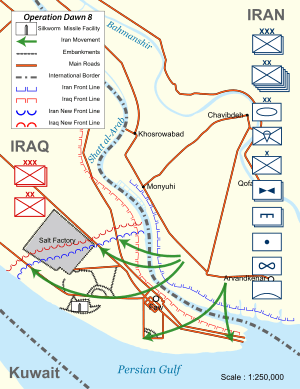Operation Dawn 8
| Operation Dawn 8 | |||||||||
|---|---|---|---|---|---|---|---|---|---|
| Part of Iran–Iraq War First Battle of al-Faw | |||||||||
 | |||||||||
| |||||||||
| Belligerents | |||||||||
|
|
| ||||||||
| Commanders and leaders | |||||||||
|
|
| ||||||||
| Strength | |||||||||
| 25,000-30,000 soldiers |
100,000 soldiers 50,000 Pasdaran and Basij | ||||||||
| Casualties and losses | |||||||||
| 17,000 dead | 30,000 dead | ||||||||
Operation Dawn 8 was an Iranian military operation conducted during the Iran–Iraq War, part of the First Battle of al-Faw.
The Iranian operation is considered to be one of Iran's greatest achievements in the Iran–Iraq War. The Iranians were able to capture the al-Faw Peninsula, cutting off Iraqi access to the Persian Gulf in the process; this in turn hardened Iraqi attitudes to prosecute the war. The Fao Peninsula was later recaptured by Iraqi forces near the end of the war by the massive and illegal use of chemical weapons.
Iranian offensive
On 9 February 1986, the Iranians launched the operation, in which 100,000 troops comprising 5 Army divisions and 50,000 men from the Pasdaran and the Basij advanced in a two-pronged offensive into southern Iraq.[1] Unlike the earlier offensives, Dawn 8 was planned entirely by professional Army officers, all of whom had begun their careers under the Shah.[1] The Iranians launched a feint attack against Basra, which was stopped by the Iraqis.[1] Meanwhile, the main Iranian blow fell on the strategically important Al-Faw Peninsula, which fell after only 24 hours of fighting.[1]
The Iranians launched their assault on the peninsula at night, their men arriving on rubber boats.[2] After taking the Fao, the Iranians built a pontoon bridge and began to dig in.[2]
Iraqi counter-offensive
On 12 February 1986, the Iraqis began a counter-offensive to re-take the Fao, which failed after a week of intense fighting.[1] Saddam sent one of his best commanders, General Maher Abd al-Rashid and the Republican Guard to begin an new offensive to re-capture the Fao on 24 February 1986.[1] A new round of intensive fighting took place, centered on a three-pronged counterattack, with the Iraqis losing 10,000 men and the Iranians 30,000 over the next four days.[1] The Iraqi offensives were supported by helicopter gunships, hundreds of tanks and a huge bombing offensive by the Iraqi Air Force.[3] Despite having an advantage in firepower and the extensive use of chemical warfare, the Iraqi attempt to re-take the Fao again ended in failure.[1]
Aftermath
The fall of al-Faw and the failure of the Iraqi counter-offensives were huge blows to the prestige of the Ba'ath regime, and led to fears all over the Gulf that Iran might win the war.[1] In particular, Kuwait felt menaced with Iranian troops only ten miles away, and increased its support of Iraq accordingly.[4] During the Second Battle of al-Faw in April 1988 Iraq re-captured the peninsula.
In popular culture
The Season One of the war documentary Ravayat-e Fath depicts Operation Dawn 8.
Bibliography
References
- 1 2 3 4 5 6 7 8 9 Karsh, Efraim The Iran-Iraq War 1980–1988, London: Osprey, 2002 page 48
- 1 2 Bulloch, John & Morris, Harvey The Gulf War, Methuen: London, 1989 page 240.
- ↑ Bulloch, John & Morris, Harvey The Gulf War, Methuen: London, 1989 page 242.
- ↑ Bulloch, John & Morris, Harvey The Gulf War, Methuen: London, 1989 page 241.